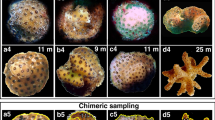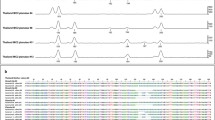Summary
Tissue grafting and electrophoresis were used to study the genotypic structure of a population of the scleractinian coral, Pavona cactus. Three growth forms were distinguished within one continuous population of this morphologically variable species. Both techniques provided evidence of localized asexual reproduction within each growth form, a result consistent with numerous field observations of naturally occurring fragments. A perfect association between clonal genotype and growth form was found in an electrophoretic survey of 80 colonies. 23 multi-locus genotypes were detected in the 80 colonies tested. All genotypically similar colonies had the same growth form, even where colonies were separated by 50 m. Although environmental gradients undoubtedly modify colony morphology, the high correlation between genotype and growth form suggests that major differences in colony morphology are genetically determined.
Tissue grafting tests did not reliably identify all clones. Fusions developed between all electrophoretically indistinguishable colonies, consistent with the initial assumption that fusion between paired colonies would indicate ‘selfrecognition’. However, there was also one fusion in 20 pairings of electrophoretically different colonies. Although there was general agreement between the two techniques, the one inconsistent fusion suggests that caution should be exercised in the application of histocompatibility tests as bioassays for clonal population structure, and that electrophoresis is the more appropriate technique for this species.
The ability of genotypes to dominate in intraspecific competitive interactions and to survive fragmentation was assessed. An intraspecific dominance hierarchy was identified among the 6 clones tested. Competition was highly asymmetrical between dominant and subordinate-ranking clones. Genotypes that were most successful in producing widespread clones were found to dominate intraspecific competitive interactions and had high rates of fragment survival.
Similar content being viewed by others
References
Ayre DJ (1983) The effects of asexual reproduction and intergenotypic aggression on the genotypic structure of populations of the sea anemone Actinia tenebrosa. Oecologia (Berlin) 57:158–165
Ayre DJ (1984) The effects of sexual and asexual reproduction on geographic variation in the sea anemone Actinia tenebrosa. Oecologia (Berlin) 62:222–229
Bak RPM, Termaat RM, Dekker R (1982) Complexity of coral interactions: influence of time, location of interaction and epifauna. Mar Biol 69:215–222
Black R, Johnson MS (1979) Asexual viviparity and population genetics of Actinia tenebrosa. Mar Biol 35:27–31
Boschma H (1948) The species problem in Millepora. Zool Verh Rejks Mus Leiden 1:1–115
Bradbury RH, Young PC (1983) Coral interaction and community structure: An analysis of spatial pattern. Mar Ecol Prog Ser 11:265–271
Chornesky EA (1983) Induced development of sweeper tentacles on the reef coral Agaricia agaricites: A response to direct competition. Biol Bull 165:569–581
Connell JH (1976) Competitive interactions and the species diversity of corals. In: Mackie GO (ed) Coelenterate ecology and behavior. Plenum Press, New York, pp 51–58
Connell JH (1983) On the prevalence and relative importance of interspecific competition: evidence from field experiments. Am Nat 122:661–696
Cope M (1981) Interspecific coral interactions in Hong Kong. Proc Fourth Inter Symp on Coral Reefs. Manila 2:357–362
Curtis ASG, Kerr J and Knowlton N (1982) Graft rejection in sponges. Transplantation, 33:127–133
Foster AB (1979) Phenotypic plasticity in the reef corals Montastraea annularis (Ellis and Solander) and Siderastrea siderea (Ellis and Solander). J Exp Mar Biol Ecol 39:25–54
Graus RR, Macintyre IG (1982) Variation in growth forms of the reef coral Montastraea annularis (Ellis and Solander): A quantitative evaluation of growth response to light distribution using computer simulation. In: Rutzler K, Macintyre IG (eds) The Atlantic Barrier Reef Ecosystem at Carrie Bow Bay. Belize I. Smithsonian Contrib. Mar Sci 12:441–464
Harris H, Hopkinson DA (1976) Handbook of enzyme electrophoresis in human genetics. North-Holland, Amsterdam
Heyward AJ, Stoddart JA (1985) Genetic structure of two species of Montipora on a patch reef; conflicting results from electrophoresis and histocompatibility. Mar Biol (In press)
Hidaka M (1984) Tissue compatibility between colonies and between primary polyps of Pocillopora damicornis: A preliminary study. In: Jokiel PF and Richmond RH (eds) Coral Population Biology. HIMB Tech Rpt 37. (In press)
Highsmith RC (1982) Reproduction by fragmentation in corals. Mar Ecol Prog Ser 7:207–226
Hildemann WH, Raison RL, Cheung G, Hull CJ, Akaka L, Okamoto J (1977) Immunological specificity and memory in a scleractinian coral. Nature 270:219–223
Hildemann WH, Jokiel PL, Bigger CH, Johnston IS (1980) Allogenic polymorphism and alloimmune memory in the coral, Montipora verrucosa. Transplantation 30:297–301
Jokiel PL, Hildemann WH, Bigger CH (1982) Frequency of intercolony graft acceptance or rejection as a measure of population structure in the sponge Callyspongia diffusa. Mar Biol 71:135–139
Jokiel PL, Hildemann WH, Bigger CH (1983) Clonal population structure of two sympatric species of the reef coral Montipora. Bull Mar Sci 33:181–187
Lang J (1973) Interspecific aggression by Scleractinian corals. 2. Why the race is not only to the swift. Bull Mar Sci 23:260–279
Maragos JE (1972) A Study of Hawaiian reef corals. Ph.D. Thesis. University of Hawaii, 1–292
Marshall SM, Stephenson TA (1933) The breeding of reef animals I. The Corals. Sci Rep Great Barrier Reef Exped 1928–1929, Br Mus (Nat Hist) 3 (8):219–245
Neigel JE, Avise JC (1983 a) Clonal diversity and population structure in a reef-building coral, Acropora cervicornis: self-recognition analysis and demographic interpretation. Evolution 37:437–454
Neigel JE, Avise JC (1983 b) Histocompatibility bioassays of population structure in marine sponges. Clonal structure in Verongia longissima and Lotrochota birotulata. J Hered 74:134–140
Neigel JE, Schmahl GP (1984) Phenotypic variation within histocompatibility-defined clones of marine sponges. Science 224:413–415
Potts DC (1978) Differentiation in coral populations. Atoll Res Bull 220:55–74
Purcell JE, Kitting CL (1982) Intraspecific aggression and population distributions of the sea anemone Metridium senile. Biol Bull 162:345–359
Rinkevich B, Loya Y (1983) Intraspecific competitive networks in the Red Sea coral Stylophora pistillata. Coral Reefs 1:161–172
Sebens KP (1984) Agonistic behavior in the intertidal sea anemone, Anthopleura xanthogrammica. Biol Bull 166:457–472
Selander RK, Smith MH, Yang SY, Johnson WE, Gentry JB (1971) Biochemical polymorphism and systematics in the genus Peromyscus. I. Variation in the Old-Field Mouse (Peromyscs polionotus). Studies in Genetics VI Univ Tex Publs 7103:49–90
Sheppard CRC (1979) Interspecific aggression between reef corals with reference to their distribution. Mar Ecol Prog Ser 1:237–247
Shick JM, Hoffmann RJ, Lamb AN (1979) Asexual reproduction, population structure and genotype environment interactions in sea anemones. Am Zool 19:699–713
Stephenson TA, Stephenson A (1933) Growth and asexual reproduction in corals. Sci Rep Great Barrier Reef Exped 1928–1929. Br Mus (Nat Hist) III (7):167–217
Stoddart JA (1983 a) Asexual production of planulae in the coral Pocillopora damincornis. Mar Biol 76:279–284
Stoddart JA (1983 b) A genotypic diversity measure. J Hered 74:489–490
Stoddart JA (1984) Genetical structure within populations of the coral Pocillopora damicornis. Mar Biol 81:19–30
Tunnicliffe V (1979) The role of boring sponges in coral fracture. In: Levi C (ed) Biologie des Spongiaires (Colloque Internationaux du Centre National de la Recherche Scientifique, Paris) 291:309–315
Veron JEN (1981) The species concept in ‘Scleractinia of Eastern Australia’. Proc Fourth Int Coral Reef Symp Manila, 1981, 2:183–186
Veron JEN, Pichon M (1976) Scleractinia of Eastern Australia Part I. Families Thamnasteriidae, Astrocoeniidae, Pocilloporidae. Australian Institute of Marine Science Monograph Series 1:1–86
Veron JEN, Pichon M (1980) Scleractinia of Eastern Australia Part III. Families Agariciidae, Siderastreidae, Fungiidae, Oculinidae, Merulinidae, Mussidae, Pectinidae, Caryophylliidae, Dendrophylliidae. Australian Institute of Marine Science Monograph Series 4:1–422
Wellington GM (1980) Reversal of digestive interactions between Pacific reef corals: mediation by sweeper tentacles. Oecologia (Berlin) 47:340–343
Wood Jones F (1907) On the growth forms and supposed species in corals. Zool Soc Lond Proc 518–556
Yonge CM (1968) Review Lecture: Living Corals. Proc R Soc (B) 169:329–344
Author information
Authors and Affiliations
Additional information
Offprint requests to: D.J. Ayre Contribution No 252 from the Australian Institute of Marine Science
Rights and permissions
About this article
Cite this article
Willis, B.L., Ayre, D.J. Asexual reproduction and genetic determination of growth form in the coral Pavona cactus: biochemical genetic and immunogenic evidence. Oecologia 65, 516–525 (1985). https://doi.org/10.1007/BF00379666
Received:
Issue Date:
DOI: https://doi.org/10.1007/BF00379666




